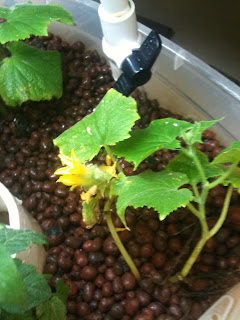After 4 hours of shifting wires and moving parts around yesterday we were finally able to test each of our controls, collect data, and produce great graphs.
If you watched the videos from yesterday you saw how we manipulated each control in an isolated volume of water. After adding a disturbance for pH there is no immediate control input, instead there is a 2 min delay but we do continue to gather data into our database. The actuator only dispenses after the average results are collected. This average, if you recall, are 10 data points or collections at 8 seconds apart. So a total of 80 sec. passes before there is some action from actuator. Vardhman programmed the system this way to allow the added control (fluid, etc.) to diffuse through water before taking the appropriate next steps. The disturbance in this experimental trial was added at 20 sec. (pH right above 7), levels dropped to just under 7 (fluctuating a little), and after 2 minutes a volume of pH corrector was added; system continued to collect data, averaging points. One factor different to this graph compared to all others is that Vardhman's algorithm allows for a much smoother sloped line and removes every data point collected every 8 sec. that would otherwise show sharp and steep lines. The graph also shows where control is turned off and levels rise back to normal. The reestablished conditions of our sampled water is a reliable control system.
Recall this block diagram for pH:
Similar to pH we used an isolated volume of water to test tank refill. The video shows how we used Velcro to constrain two sonars and pumped water from a reservoir. We started our data collection with water height of 19 cm, pump turned on for a total time of nearly two minute until the desired depth of 14 cm, pump then turned off.
Recall DO block diagram:
Our food dispenser in action:
http://www.youtube.com/watch?v=ElC4d9C1gHY&feature=youtu.be
Pic of dispenser:
.jpg)
.jpg)


.jpg)
.jpg)
.jpg)
.jpg)

.jpg)
_vs_time+(2).jpg)
.jpg)
.png)
.jpg)
.jpg)
.png)
_vs_time+(2).jpg)
.jpg)
.png)
.jpg)





























